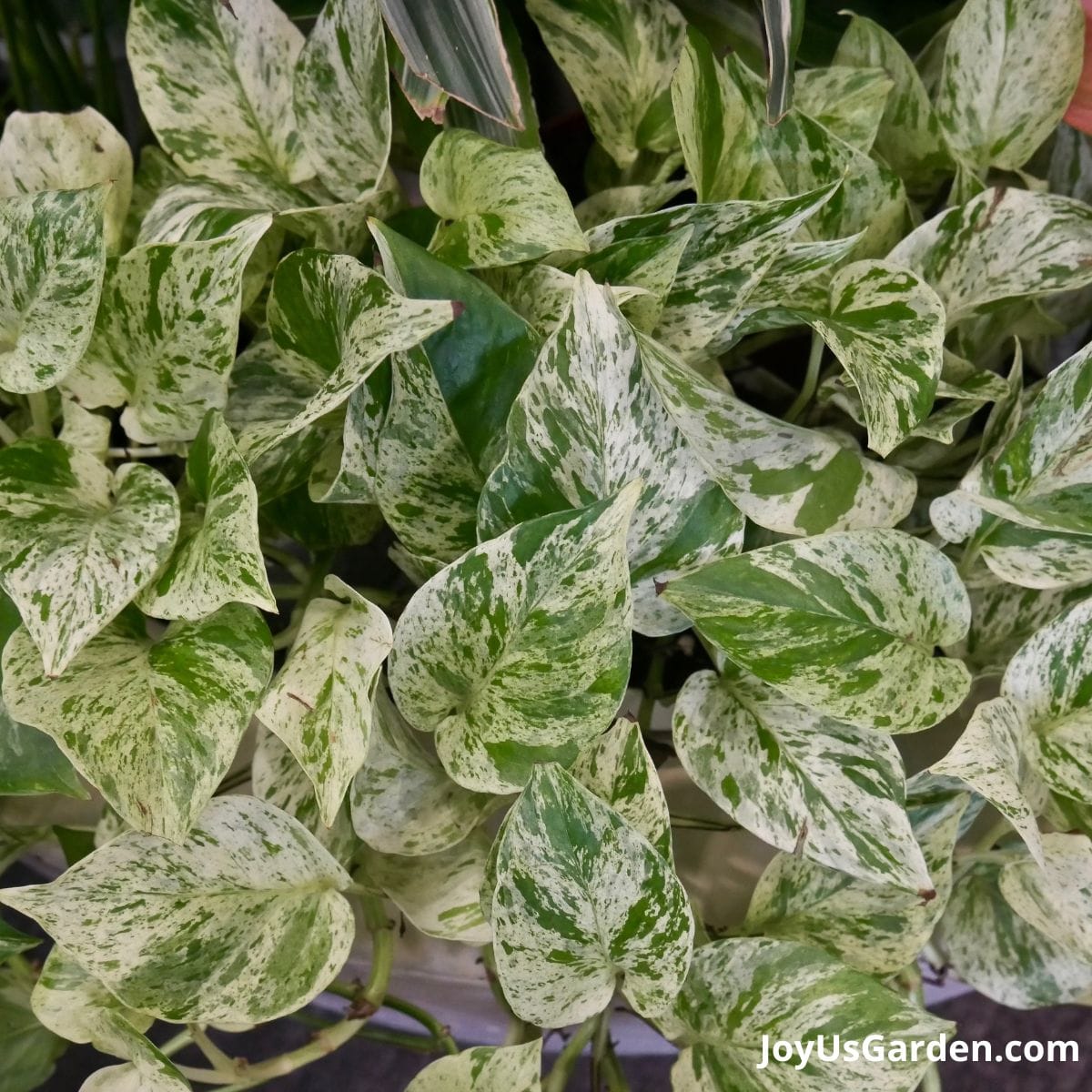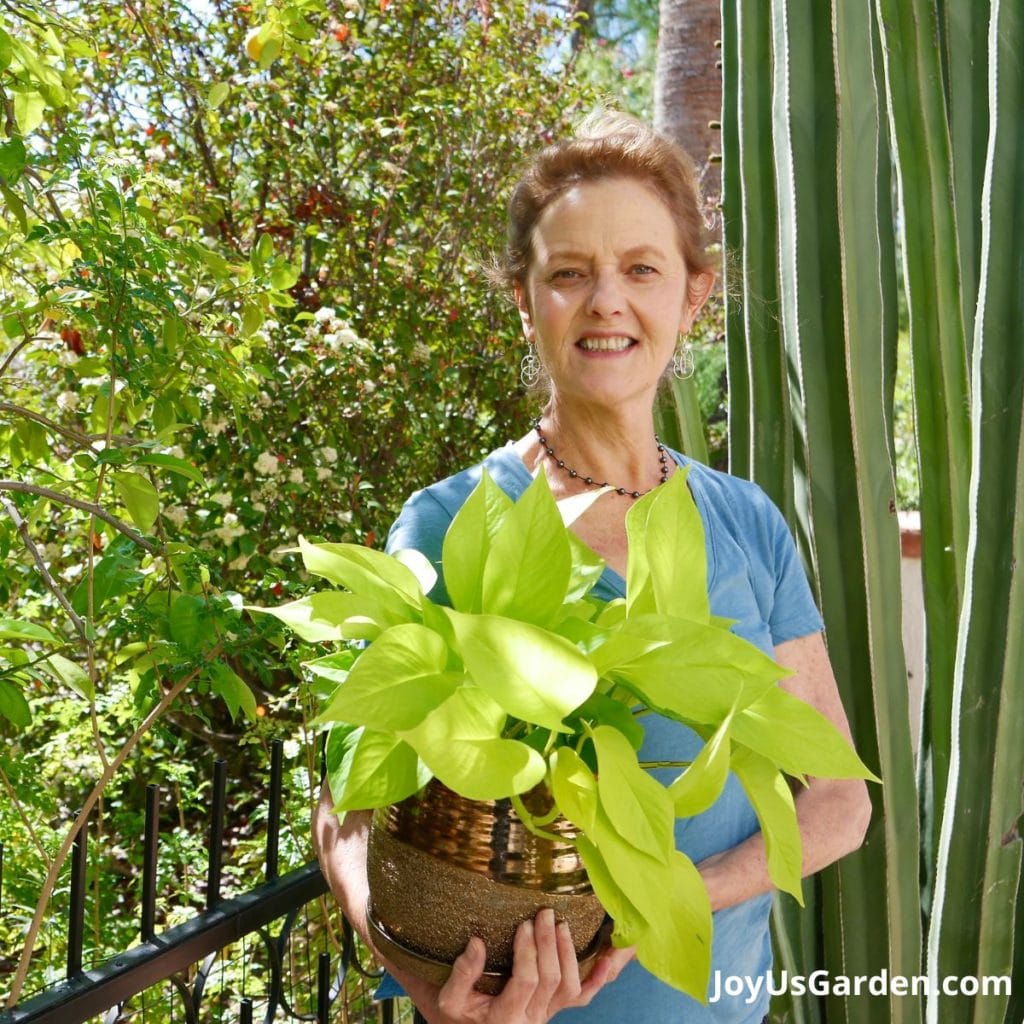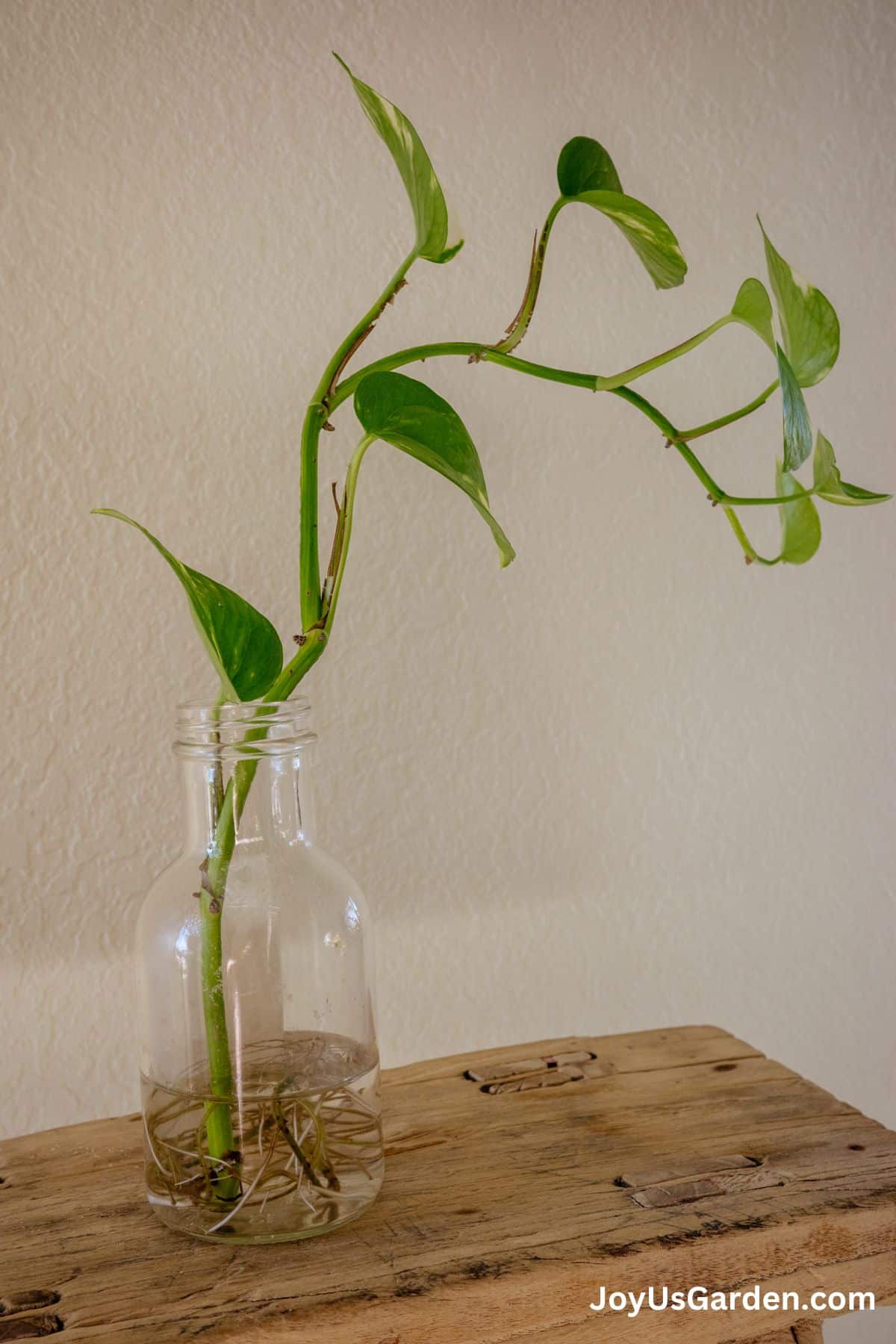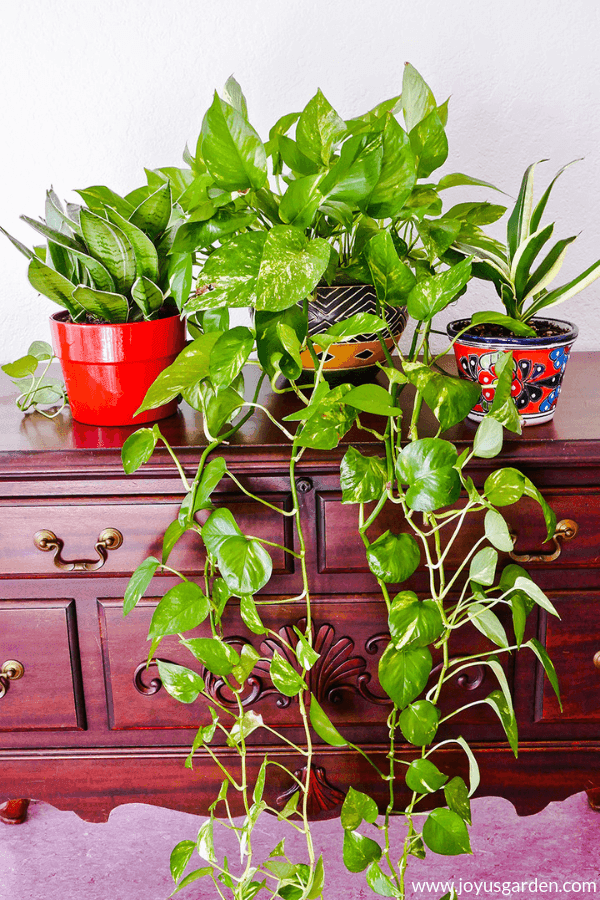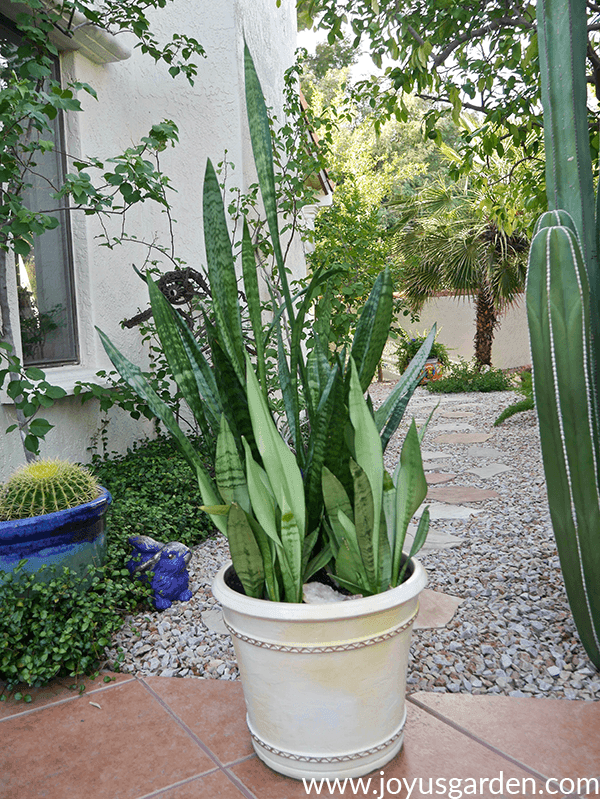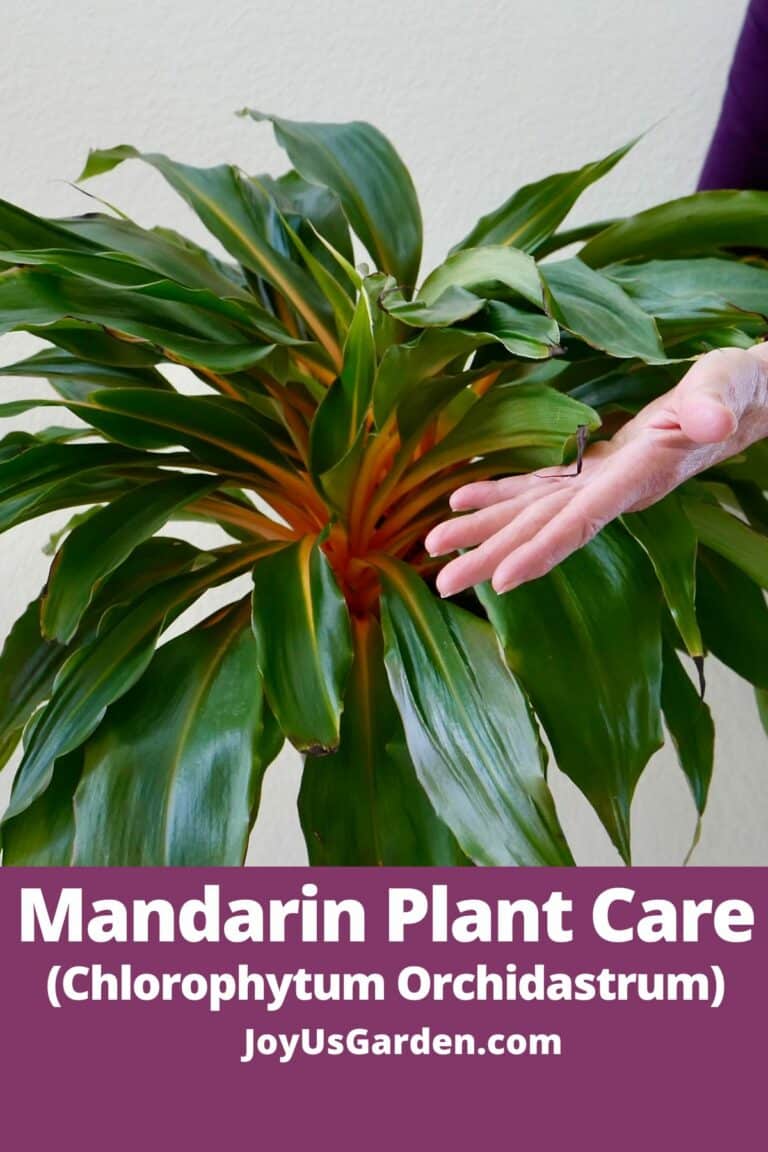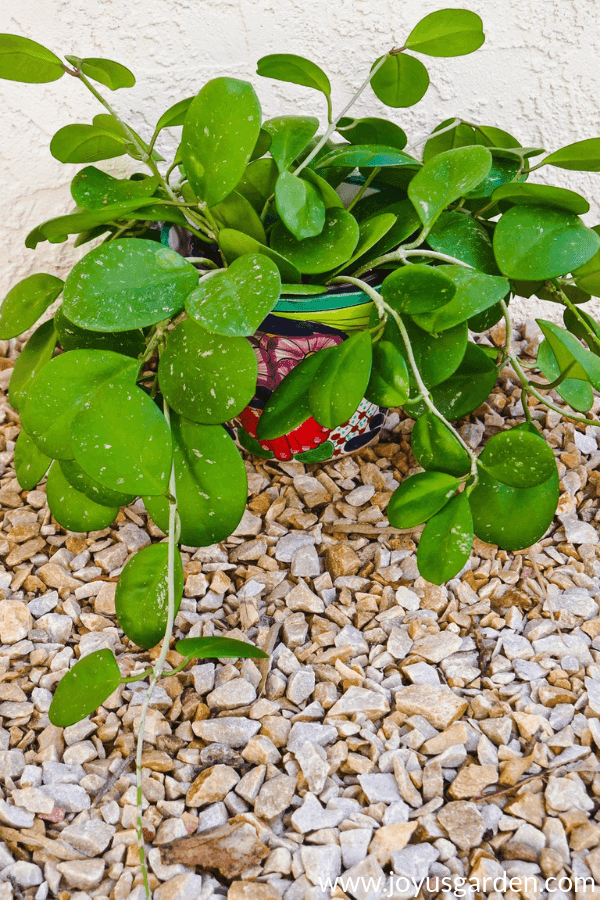Golden Pothos Plant Care: Devil’s Ivy Growing Guide
If you’re a beginning gardener looking to start your houseplant care journey, an easy plant to start with is Golden Pothos. They’re low maintenance and one of the most popular houseplants, so you won’t have trouble finding them at your local garden center or nursery. Learn about Golden Pothos plant care and how to keep this trailing plant healthy and happy.
I started my horticultural career in the interior landscaping trade. Golden Pothos plants were among the most popular plants to add greenery to offices, lobbies, hotels, banks, airports, and malls. They would instantly add beauty to the environment with their lush, trailing vines.
Does anyone remember the Hyatt hotel atriums with their floors upon floors of hanging plants? Those were Golden Pothos (at least at the one in Cambridge, MA), and I maintained them for a year. I got my fill of pothos!
Besides being one of the easiest houseplants to maintain, they’re easy to find, and buying one will barely put a dent in your wallet. You can buy a beautiful trailing Pothos in a 6″ pot with long stems for around $20. Plus, they add a lush tropical vibe to your home.
Golden Pothos plant care doesn’t require much fuss. These plants are incredibly hardy and can survive with minimal care and attention, making them an ideal choice for those who don’t have a green thumb. If you’re new to the world of indoor plants, by all means, give this one a go, and you’ll feel your thumbs getting greener!
Botanic name: Epipremnum aureum Common name: Pothos, Devil’s Ivy
Golden Pothos Plant Traits
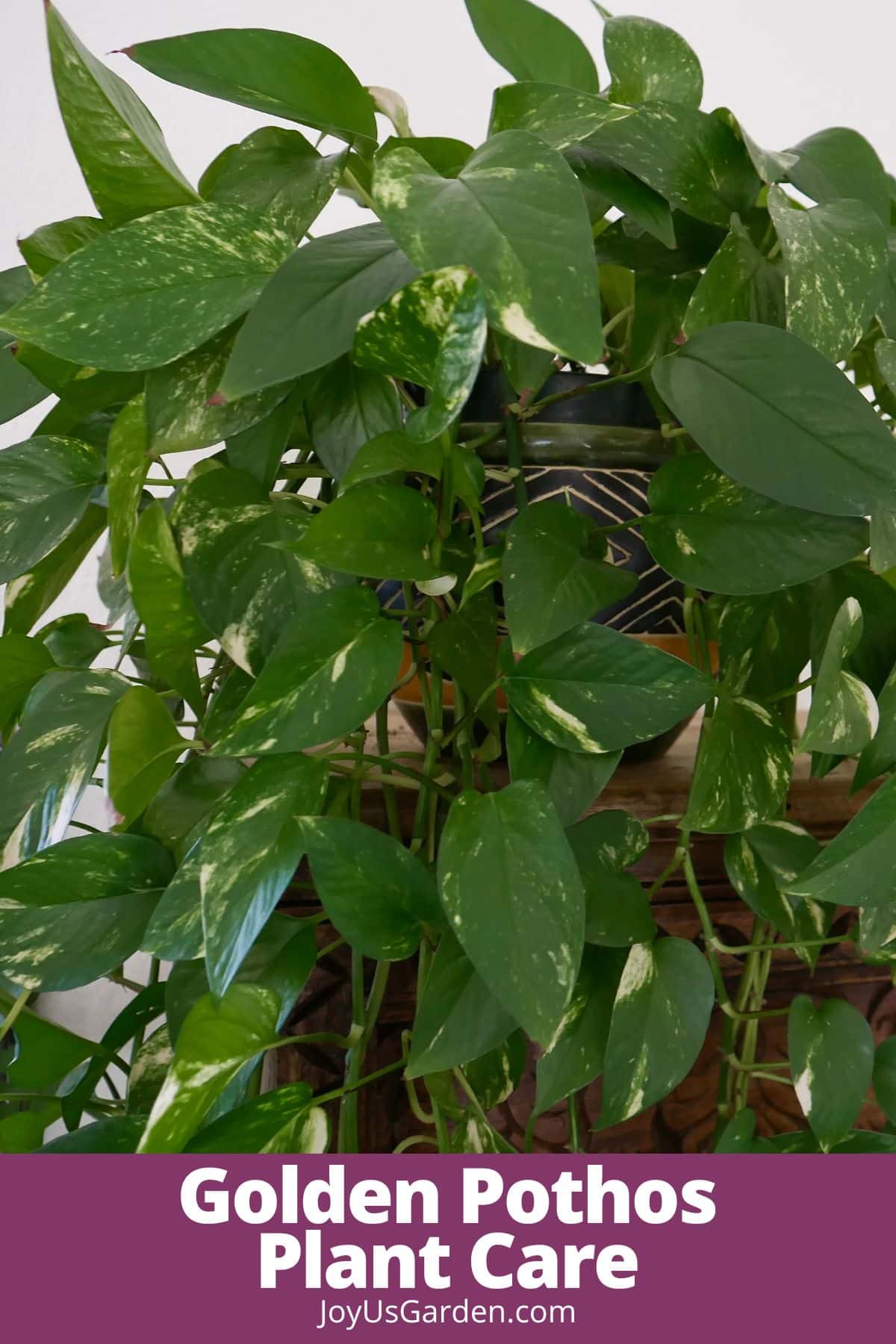
How to Use Golden Pothos
Pothos are trailing plants and are great to use in a hanging container. I have my Golden Pothos in a ceramic pot (it’s still in the grow pot) that sits atop my bookcase and trails down two sides and across the floor. The trails are over 10′ long and make for an eye-catching feature when you walk in the front door.
Used at the base of a floor plant in a large container, Pothos look good and do well as under plantings. They disguise a grow pot beautifully, so consider them an alternative to moss!
This plant loves to have its trails dangling, so don’t be afraid to hang your Pothos if you’d like it to trail down gracefully.
I’ve also seen them growing upright over hoops, on a tall piece of wood or bark, on trellises, attached to walls and moss poles, and in dish gardens and living walls.
Size
You can buy them in 4, 6, 8, and 10″ grow pots. The 6 – 10″ pots often have hangers attached. They’re easy to snap off if you wish to remove them.
Growth Rate
Pothos are moderate to fast growers indoors, especially in warm temperatures. Growth in the winter slows down for most houseplants; don’t be surprised if you’re not seeing any growth in the cooler months.
Pothos growing in low light conditions will also have a slower growth rate. If you have the space for it to grow in higher light, take advantage of it and get some faster growth. Plus, the plant will look better!
How Long Does A Pothos Grow?
In their native environments, they climb up trees and reach 60′. That’s why they’re considered invasive, hard to eliminate, and have earned another common name: Devil’s Ivy. Fortunately, we don’t have to worry about this in our homes!
My Golden Pothos is over 10′ long. I have it atop a tall bookcase, and the trails extend well past the height of the shelf and are draped on the floor of my living area.
Pothos Varieties
So many! These are the ones that I’ve seen: Golden Pothos, Marble Queen Pothos, Jade Pothos, Neon Pothos, Pothos NJoy, Glacier Pothos, Pothos Snow Queen, Jessenia Pothos, Blue Pothos, Silver or Satin Pothos. The Silver Pothos is a different genus but is commonly grouped in with the Pothos of its common name.
Growers in different parts of the country, mainly in Florida, California, Texas, and Hawaii, grow different Pothos plants, so you may be unable to find all these. Golden Pothos, Marble Queen Pothos, Neon Pothos, and Jade Pothos (this one is solid green) are the most commonly sold. All have heart-shaped leaves.
Golden Pothos Plant Care And Growing Guide
Golden Pothos Light Requirements
Generally, it grows best in medium to high bright light. Moderate light (bright indirect light) is the sweet spot for growing a Golden Pothos plant.
They won’t grow much in low-light conditions and begin to look leggy and sparse. Just remember, low light isn’t no light. A Golden Pothos (and the other variegated types) will lose variegation and revert to solid green in low light conditions.
High light is fine for a Golden Pothos, as long as it’s at least 8-10′ away from a west or south-facing window. They can burn in direct, hot sunlight. Growing in indirect sunlight is fine.
Mine grows atop a bookcase next to a north-facing picture window. There are windows across the room. I live in sunny Tucson, AZ, so it gets plenty of indirect light all day.
If you notice the leaves leaning towards the light source, rotate the plant occasionally so it can receive adequate light from all sides.
If you notice the light in the spot yours is growing in has lessened significantly in winter, consider moving it to a spot with more light. More on winter houseplant care here.
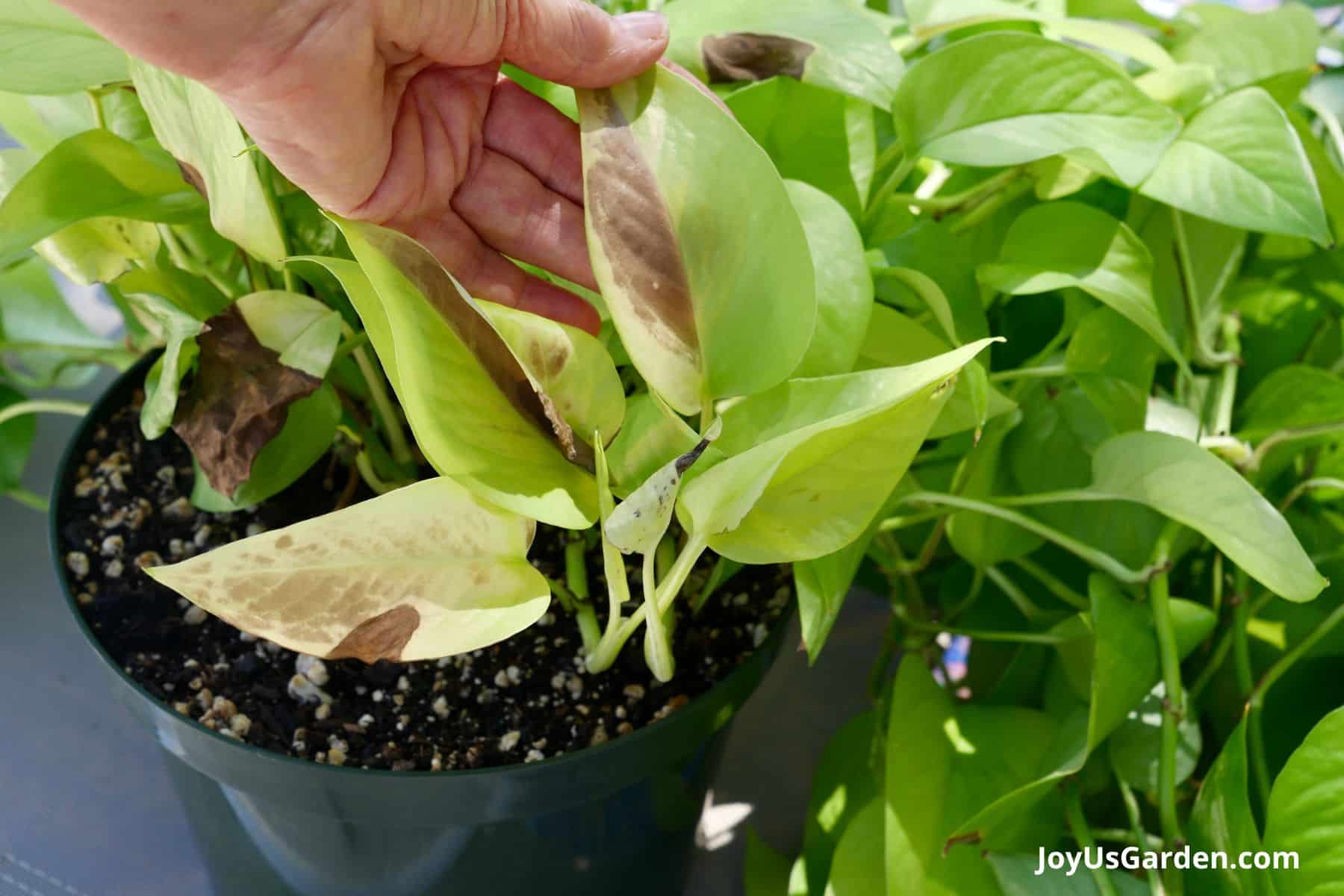
I’ve done a post & video answering your FAQs About Pothos Plants that you’ll find helpful.
Golden Pothos Watering
I thoroughly water my Golden Pothos when the soil goes almost dry.
Here in the desert (I live in warm, sunny Tucson, AZ), that’s once every 6-7 days in the warmer months. It’s less often in the winter, maybe every 9-14 days.
I can’t give you an exact watering schedule; watering requirements vary depending on your home’s environment, type of soil mix, and pot size.
Pothos are subject to root rot, so keeping the soil on the dry side is preferred to them being in constant wet soil.
Having drainage holes on the bottom of the pot so the excess water can freely flow out is necessary. Be sure not to let too much water build up in the saucer (if you have one underneath the pot).
In the winter months, it’ll need less water. This is also the preferred time to hold off on fertilizing and pruning.
I’ve done a guide to watering indoor plants that you may find helpful.
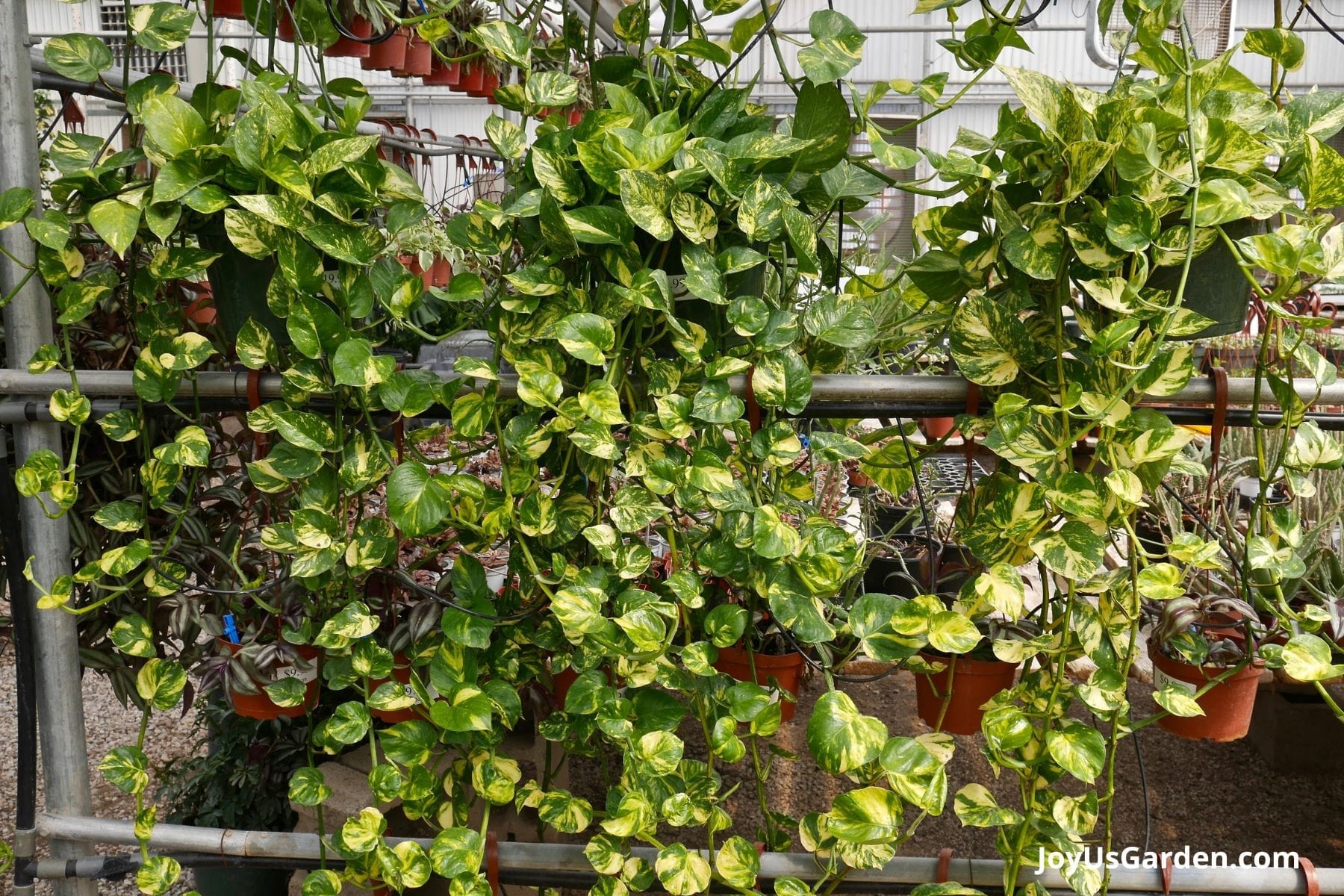
Temperature
This isn’t a big deal when it comes to pothos care. They tolerate a wide range of temps. If your house is comfortable for you, it’ll also be so for your pothos and other houseplants.
Just keep them away from cold drafts and heating or air conditioning vents.
Humidity
Pothos are tropical plants and grow in regions with high humidity. Despite this, they tolerate the lower humidity levels in our homes like a champ. If you see occasional brown leaf tips, that most likely is a reaction to dry air.
If you’re interested in upping the ante on the humidity factor in your home, this is what I do:
I have this humidity meter in my dining room. It’s inexpensive but gets the job done and still works fine after a few years. I run my Canopy humidifiers at night when the humidity reads low, often in the Arizona desert!
Misting a couple of times a week will help.
Pothos Fertilizing
Spring and summer are the best time to fertilize your plants. You can extend into early fall if you’re in a temperate climate.
We have a long growing season here in Tucson from mid-February through October. I fertilize with Maxsea or Sea Grow, Grow Big, and Liquid Kelp seven times (once per month) during the growing season. It’s how I feed all my tropical plants. I alternate using these granular and liquid fertilizers individually and don’t mix them.
Luckily, pothos aren’t fussy or needy when it comes to fertilizing. Keep in mind fertilizing too often will do more harm than good. Depending on your climate and growing zone, feeding two or three times a year may do it for your indoor plants.
Whatever houseplant food you choose, don’t use more than the recommended amount or do it too often because salts build up and can burn the plant’s roots. Overfertilized plants often show brown spots and/or large brown tips on their leaves.
I don’t fertilize houseplants in late fall and winter because it’s not their active growing season. You also want to avoid fertilizing any stressed houseplant, i.e., bone dry or soaking wet.

Soil For Pothos
For my Golden Pothos, I always use good quality potting soil formulated for houseplants, which is peat-based, well-nourished, and drains well.
These are the potting soils I alternate between using: Ocean Forest and Happy Frog. I also add in a few amendments when planting. You can read more about my soil blend by clicking on the link in the “Repotting” section below.
Repotting/Transplanting
Spring and summer are the best times to repot your Golden Pothos. Early fall is a fine time to repot if you live in a warmer climate.
When I repot, I usually go up a pot size – from a 4″ to 6″ pot. If your 6″ Pothos is large and extremely pot-bound, you can put it into a 10″ pot.
If you see the roots growing out of the bottom, that’s a sign that it’s time to repot. Generally, I repot my Pothos every five years so the roots have more growing room and fresh soil.
Depending on how long the trails are, it can turn into a tangly mess when repotting. An option would be gently tying up the trails to keep them out of the way while repotting.
The type of pot doesn’t matter. I’ve grown them in plastic pots and directly planted them in terra cotta. Fiberglass, resin, or ceramic would be just fine too.
It’s best if your pot has at least one drainage hole on the bottom so the excess water doesn’t build up.
This post on Pothos Repotting details how to repot pothos plus the soil mix to use.
Pothos Pruning
These plants grow fast, so pruning is essential to pothos plant care.
You can prune your pothos to control the length by cutting straight across the stem right below a leaf node. Doing this also stimulates new growth at the top.
Pinching or pruning off the tips of the trails (1-2 nodes back) will do the same. I’ve done both to my Golden Pothos, and it’s kept a lot of fullness on top.
I’ve seen pothos stems with some growth at the top, no leaves in the middle, and a bit at the ends. The bare parts of the stem with no leaves won’t ever have them grow back.
Cut off those stems (along with the bare middles), propagate them, and plant them back in the pot. This will rejuvenate your plant.
Like fertilizing and repotting, pruning is best done in the spring and summer.
Propagating Pothos
Propagating a Golden Pothos is a breeze. I always propagate mine in water with great success. Aerial roots form off the nodes of the stems, so they’re already on their way to rooting for you.
Remove enough leaves off the stems (usually 1-4, depending on how long your cuttings are) to get them in water. It’s best to keep the leaves out of the water. Fill your glass or jar with enough water to cover one to two nodes.
Keep the water at this level and change it out as needed. More roots will appear in no time, usually seven to ten days.
The longest I’ve kept my Pothos stem cuttings in water was eight months, and they looked fine. I’ve heard they can grow in water for a long time.
This post and video on Pothos Propagation will give you more details on propagating and pruning.
Pests
When I lived in Santa Barbara, my pothos got mealybugs. I spotted them early on and took action.
While working as an interior landscaper, I saw pothos infested with spider mites and scale.
Pests can travel from houseplant to houseplant fast and multiply like crazy, so make sure you get them under control as soon as you see them.
For most pest infestations, you can control them with neem oil or insecticidal soap. The latter is what I’ve been using for two years now and has been effective.
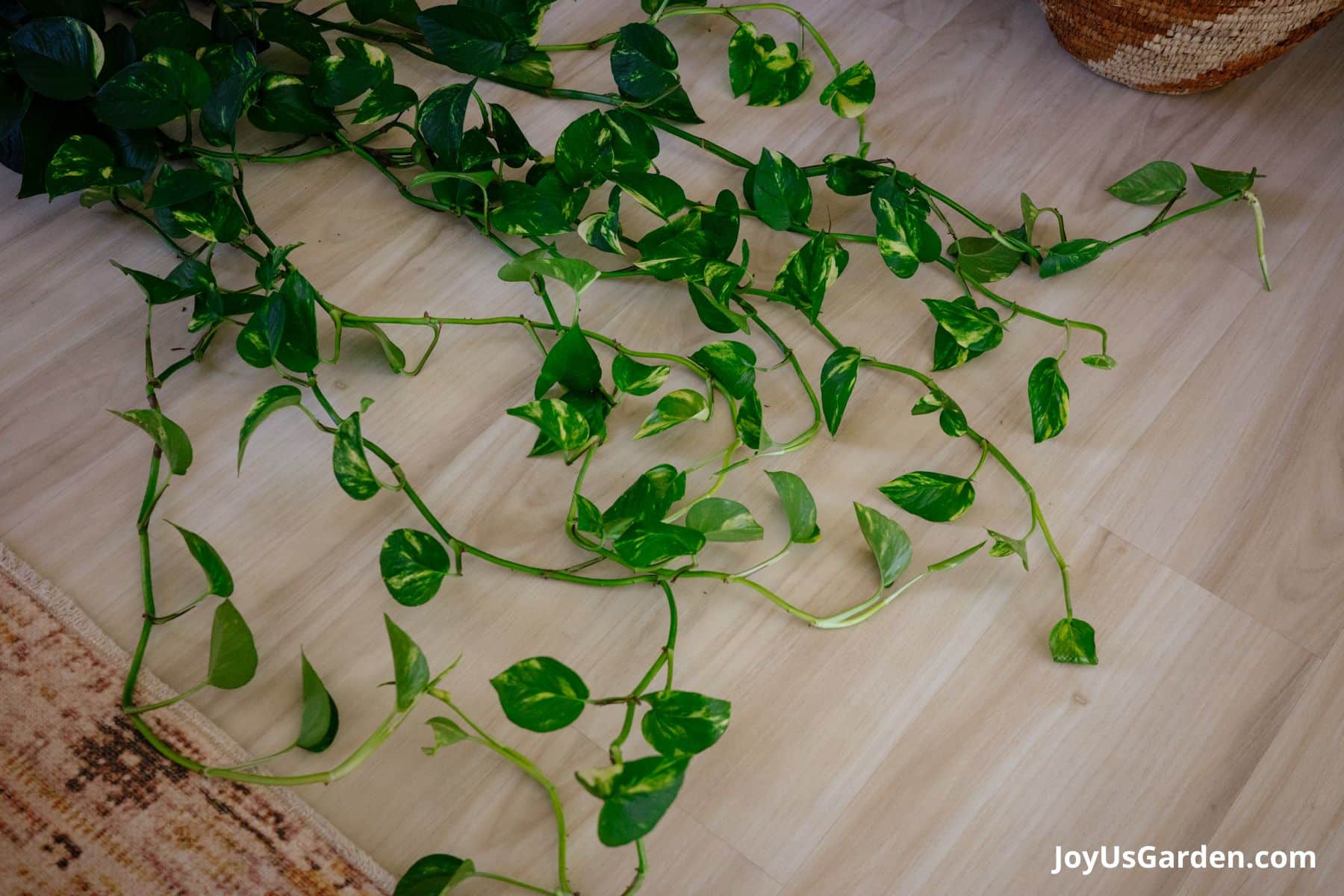
Yellow Leaves On Pothos Plants
An occasional yellow leaf is a natural occurrence for any plant. It’s part of their growth process. I remove a yellow leaf or two from my Golden Pothos every couple of months.
However, an excessive amount of yellow leaves is a sign that the plant isn’t happy. The cause could be overwatering, underwatering, too much fertilizer, too much light or not enough light, and/or poor soil drainage. Watering too often is the most common reason.
You can remove any yellow leaves to keep the plant looking good.
Toxic To Cats & Dogs
Pothos are considered to be toxic to pets. I consult the ASPCA website for my info on this subject and see in what way the plant is toxic. Here’s more info on this for you.
If your pets are prone to chewing on plants, I recommend placing your pothos up high or hanging it, making it difficult for them to reach.
Golden Pothos Plant Care FAQs
Yes, they are one of the easiest plants for beginning gardeners. Golden Pothos require little maintenance and aren’t fussy. They thrive in bright, indirect light and are vigorous growers with the right care.
Golden Pothos plants are climbers in their natural habitat. As houseplants, they can be grown either way. Use a small trellis, hoop, piece of wood with sphagnum moss, or moss pole if you want your plant to climb. Use macramé hangers, hanging baskets, or a hanging shelf for a trailing display.
A Golden Pothos needs bright, indirect light to do and look its best. Too much sun will cause the leaves to burn and yellow. If necessary, you can place your plant near (but not in) a west or south-facing window for more light.
In conclusion, Golden Pothos plant care is a breeze, and their long, lush trails are another big draw. They’re low-maintenance and versatile houseplants that can be grown as climbers or trailers. Water them when the soil is almost dry. They require bright, indirect light to thrive and should not be placed in direct sunlight.
You can keep your Golden Pothos looking its best with proper care and attention. Let the trailing begin!
Happy gardening,

